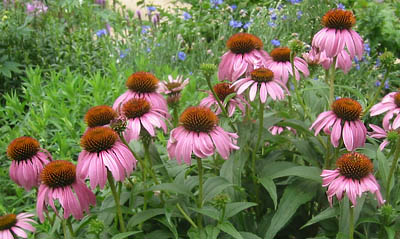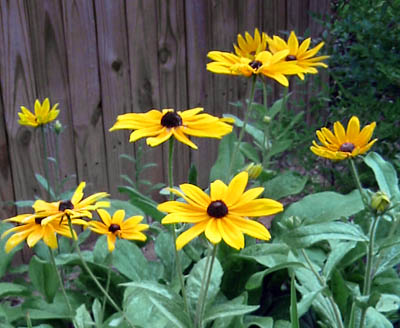Go Native
The importance of native species

Purple coneflower – Echinacea purpurea
Pick up any magazine today or listen to any broadcast about gardening and the environment, and you are likely to encounter the term, native species. Many gardeners are turning to native species these days, not to jump on the latest media bandwagon, but because natives make good environmental sense.
Meaning of native
Definitions of the native species can vary. Some define natives as plants that were growing on our continent before Europeans arrived with new species. Others more strictly define natives as species that have evolved on their own without human involvement in a particular region. For example corn, which was brought from Central and South America, would not be native to North America, even though it was cultivated here before Columbus. Camassia that originally grew wild in our Pacific northwest is sold as a native species, but by the latter definition, would not be a native here in Virginia.
Native benefits
Natives have several advantages over cultivated or introduced species. Natives have evolved over millennia to grow and thrive in the soil, rainfall, nutrients, and wildlife found in a particular region. Virginia native species find a home in our hot, humid summers, receiving intermittent rainfall and tolerating the clay soil because they evolved to do so over thousands of years. Many tropical annuals, on the other hand, need watering, soil amendments, fertilizers, and pesticide help from us. Natives become important as more people want a landscape that requires minimal maintenance.

Black-eyed Susan – Rudbeckia hirti
Another benefit to growing native species is that they contribute to the ecosystem — pollinators and birds have come to depend on them. Many natives produce the type of seeds that supply food to our bird populations. Some native species have evolved to provide food at a specific time, corresponding to the time birds are feeding their young, leaving the nests, or returning from or preparing for a long migration. Goldfinches often visit local gardens to feast on native coneflower seeds (Echinacea) in late summer and to feed their young.
And lastly pollinators benefit. Pollinators are an essential part of our ecosystem and are required for plant reproduction and seed development, especially as it relates to growing our fruits and vegetables. Our urban and suburban areas with plenty of concrete and large grassy lawns provide little habitat or food for the pollinators. Historically, native plants have offered our pollinators a succession of meals through staggered bloom and seed development times. Some native flower blossoms are also uniquely shaped or configured to suit specific bees and wasps, providing them easy access to the pollen.
Not all natives are created equal

New England Aster – Aster novae-angliae
Pollen grains in human-bred plants may be differently shaped, making them less likely to stick to bees. Flowers may be differently colored, have different ultraviolet markings (visible to insect eyes), or have a slightly different scent making them unrecognizable to their normal pollinators. Seeds may have harder shells, be unable to reproduce, or have less nutritional value for birds than true natives. Flower shapes may be slightly different or larger, not fitting a pollinator’s proboscis and making it difficult to get to the pollen.
Native species have come into the mainstream over the past two decades because there are environmental benefits to growing them in our gardens. However, it is important to recognize why natives are important and to recognize that differences exist between true regional natives and cultivated hybridized natives. With this knowledge, we can be good consumers and better gardeners.
Some common easy-grow native species:
• Common Milkweed (Asclepias syriaca)
• Eastern Purple Coneflower (Echinacea purpurea)
• Black-eyed Susan (Rudbeckia hirti)
• New England Aster (Aster novae-angliae)
• Virginia Blue Bells (Mertensia virginica)
Resources
Virginia Department of Conservation & Recreation
Native Plant Center
Virginia Native Plant Society
Lady Bird Johnson Wildflower Center Native Plant Database